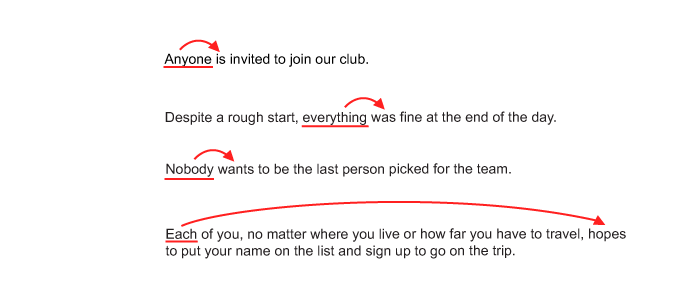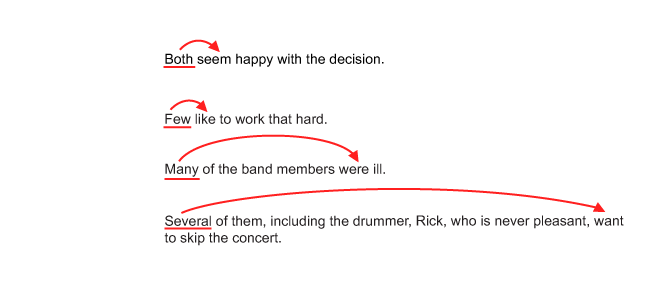When Subjects Are Indefinite Pronouns
Personal pronouns can serve as subjects. It’s fairly simple to figure out which ones are singular and which are plural: I, he, she, and it are singular and agree with singular verbs; we and they are plural and need plural verbs. You can be singular or plural, depending on whether it refers to one person or more than one. However, when indefinite pronouns are the subjects of sentences, subject-verb agreement problems can arise. It’s not as easy to determine whether these types of pronouns are singular or plural.
- Most indefinite pronouns agree with singular verbs, even though every- and some- would seem to indicate more than one. Think about this, though: one, body, and thing are all singular, right? That’s the clue as to why the pronouns in the first three rows of the table below are singular. You will need to commit the bottom row to memory.
| One words | One | Anyone | Everyone | Someone | No one |
| Body words | Anybody | Everybody | Somebody | Nobody | |
| Thing words |
Anything | Everything | Something | Nothing | |
| Each | Either | Neither |

Stop for a moment and notice that the previous sentence illustrates an important point to remember: Sometimes many words, phrases, and/or clauses separate the main subject and its verb, but no matter how long the sentence is, the subject and verb must agree.
Don’t get frustrated and become lost in the words; instead, remind yourself of the process we’ve already discussed. Systematically find the verb and ask yourself, “Who or what (put the verb in the blank)?” The answer, as you know, is the subject, and all you have to do then is to determine its number and be certain the verb agrees with that number.
- A few indefinite pronouns—including
both ,few ,many , andseveral —are plural and need a plural verb. - Six indefinite pronouns (
all ,any ,more ,most ,none ,some ) can be singular or plural subjects, depending on whether the word they refer to is singular or plural.


Check your understanding of this section by taking this short quiz. Read each sentence carefully to determine its verb and subject(s). Before you select an answer, try to identify the verb and subject(s). If the subject and verb agree, click YES; if they don’t, click NO.